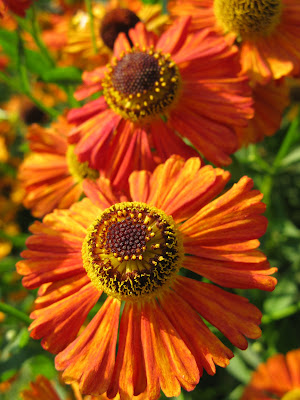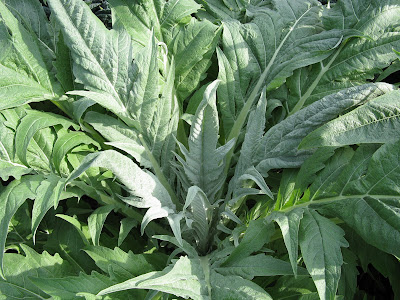In any case, here's another set of shots from the Niagara Parks' Botanical Gardens...
From the main parking lot, as one begins to enter the gardens, they pass a beautiful grass border in front of some giant conifers.


Of course, at this time of year, most of the grasses are at their peak. Here's a couple of their "flowers" or plumes, in some pleasant lighting.


Here's a Helenium in all her glory, named in fact, for Helen of Troy, but the connection between the two is somewhat ambiguous. Its common name of Sneezeweed, on the other hand, comes from the fact that the plant was originally accused of causing late summer allergies. It is however innocent to this charge, but does bloom at the same time as the actual culprit, Ragweed (Ambrosia sp.). In any case, it's an unfortunate name for such a beautiful, late summer plant.

Another late summer "beauty" is Physostegia virginina or Obedient Plant. In good, rich garden soil it has a tendency to run, particularly if the gardener does not have the ability to be ruthless on an annual basis. Its common name comes from the fact that bent stems "obediently" remain in position.

One of a couple less common plants is Gentiana clausa, or the Bottle Gentian. It is native to much of Eastern North America, including parts of Quebec. It is typically known for its flowers that appear to remain closed, but in fact, a small opening at the top is just large enough for a bee to squeeze in and look after business.

Another rarity is Kirengeshoma palmata or Yellow Waxbells, one of a few perennials from the Hydrangea family. Its horned fruit is of some ornamental interest, and is described by Allan Armitage as "Stephen King-like".

In the Rose Garden, they have some beautiful plantings of annuals and "tender perennials"...

...including Ricinus communis, the Castor Bean plant, here with a Begonia around the bottom. It is propagated by seed so there is considerable variability in leaf and stem colour. This particular plant has beautiful red stems.


Another beautiful tender perennial is Cynara cardunculus or Cardoon. For silver and textured foliage, it has to be near the top. Apparently this plant goes back to the fourth century BC. In addition, both the flower buds and the stems (stalks) are eaten. In places like California, Australia and Argentinia, it is considered to be a weed.

Finally, a few shots of a couple of magical combinations of Colchicum autumnale (Autumn Crocus) with Ceratostigma plumbaginoides (Plumbago, Blue Leadwort).



Here's to dirt under your nails... for a few more weeks. Don't forget to plant more bulbs!
Mark, the coolplantsguy





